In this article:
Don’t we all love shiny, healthy, and voluminous hair? Unfortunately, day-to-day exposure to environmental pollutants and chemical-based hair products can negatively affect the hair.
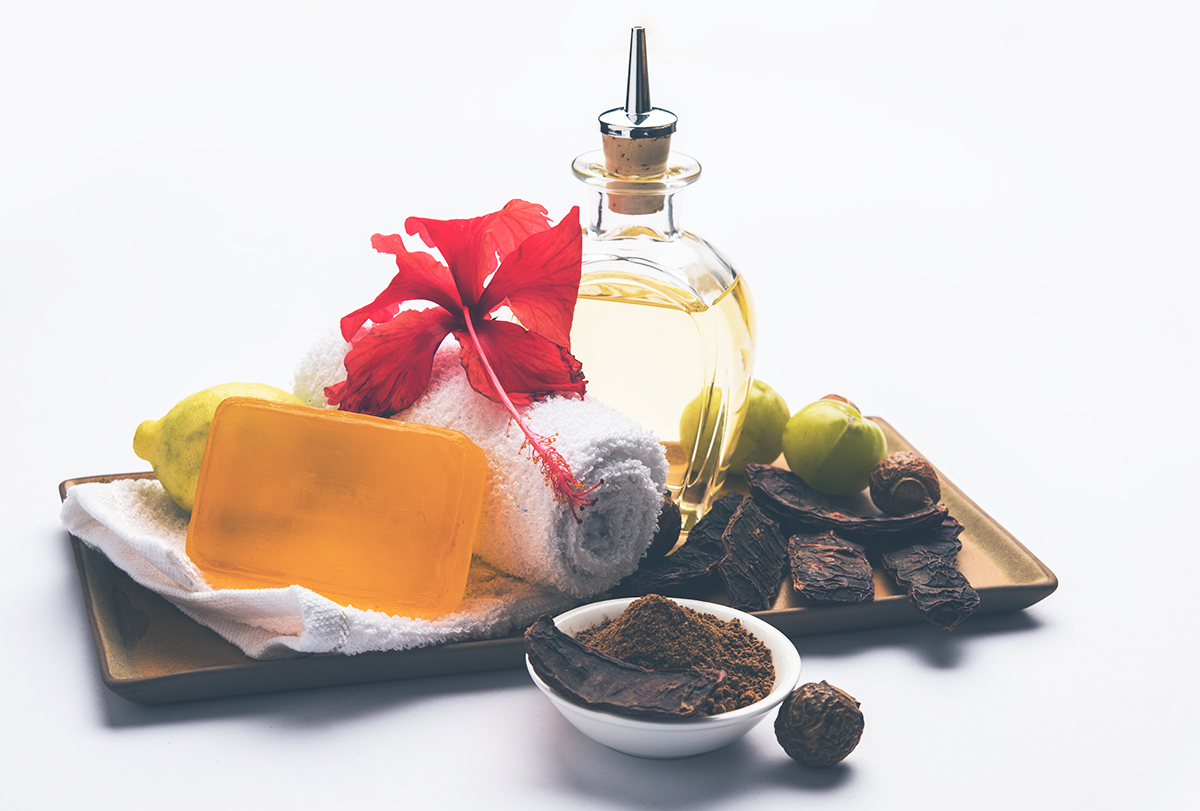
Good hair quality can also be challenged by internal factors such as thyroid abnormalities, hormonal imbalance, dieting, infections, surgery, stress, certain medications, and menopause. Hence, to improve your overall hair health, it is vital to address internal and external causative factors and seek professional treatment.
Aside from medical treatment, you can also try Ayurvedic treatments, which are often more efficient, safer, and cheaper than other treatments. Moreover, Ayurveda also helps improve your hair nutrition, volume, and health in general. (1)
Disbalanced Doshas and Hair Problems
Ayurvedic science mentions that there are three different types of energies, known as doshas, that assimilate to determine your nature, or prakriti. These doshas are namely vata, pitta, and kapha. (2)(3)
It is said that a disbalance, be it an increase or decrease, in any of the doshas can present as a medical condition. Therefore, different doshas present different hair problems.
1. Vata dosha

People with vata dosha have straight, thin hair with a coarse texture. Vata hair generally has high moisture content and absorption capability, accompanied by a rapid growth rate.
A disbalance in vata dosha is often associated with an improper diet, which can affect the hair in the following way:
- Dryness and dehydration of the scalp
- Cracking and flaking of the scalp
- Hair thinning
- Frizziness
- Split ends
- Hair fall
- Seborrheic dermatitis
2. Pitta dosha

Hair associated with pitta dosha tends to be slightly curly, soft, thick, and high in protein and pigment content. Different factors, including stress, UV radiation, environmental pollution, and poor hair hygiene, can cause an elevated pitta dosha.
A disbalance in pitta dosha, in turn, causes:
- Oiliness and greasiness
- Seborrheic dermatitis and other infections
- Erythema
- Clogging of hair follicles
- Premature graying of hair
- Weak hair roots
- Inflamed scalp
3. Kapha dosha
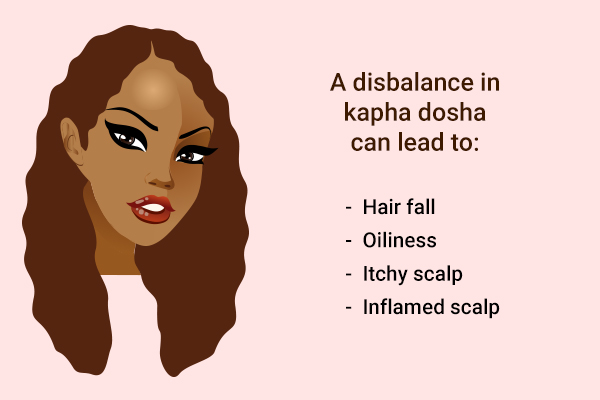
Kapha hair is characterized by thick, curly, and shiny hair strands, giving it a voluminous appearance. A kapha dosha disbalance is generally caused by hormonal fluctuations, high cholesterol, and excessive sugar intake.
The hair problems associated with increased levels of kapha dosha include:
- Hair fall
- Oiliness
- Itchy scalp
- Inflamed scalp
Ayurvedic Treatments for Hair
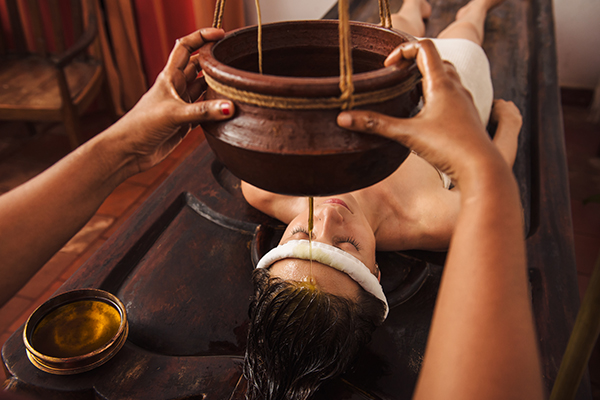
The aim of Ayurvedic treatments is to rebalance the three doshas efficiently to improve the associated problems without producing any side effects. You can use Ayurvedic therapies, medications, or products to help treat your hair problems.
1. Ayurvedic therapies
The Ayurvedic therapies used to rebalance the doshas for hair health include:
- Shiro lepa. It refers to the use of herbal hair masks, (4) which can be easily prepared at home using herb powders.
- Shiro dhara. This involves pouring warmed Ayurvedic oils on the head to help prevent hair loss and manage stress. It is best to consult an expert for this form of therapy.
- Nasya. As part of this therapy, an expert uses Ayurvedic oils to lubricate the nasal chambers. (4)
- Shiro vasti. Similar to shiro dhara, this therapy involves massaging the hair with oils to nourish the hair and reduce stress. Shiro vasti can be performed at home.
- Dhoopana. It involves smoking the hair with neem, camphor, or frankincense to treat infections. This therapy should be performed by an expert. (5)
2. Ayurvedic medications
Multiple Ayurvedic medications are available that treat a wide range of hair problems.
Some common examples include:
- Asanandi thailam
- Gandhak thailam
- Dhurdhurapatradi thailam
- Narasimha rasayanam
- Thikthakam ghritham
It is essential to consult an expert before using these medications.
3. Ayurvedic products
Most of the herbs and oils used in Ayurveda are easily available as an ingredient of different commercial hair care products.
- Shampoos containing shikakai and reetha
- Hair serums with jojoba oil, bhringraj, ginseng, japa, gotu kola, and grapeseed fruit extract
- Ayurvedic bentonite clay (6) masks to control hair sebum
- Fermented rice water, or ganji, for the treatment of greasy hair
- Triphala, which is made from haritaki, bibhitaki, and Indian gooseberry powders, is often employed in shampoos and conditioners for its antimicrobial properties. (7)(8)
Many other conditioners, growth serums, herbal lotions, tonic, leave-ins, and cleansers are available that contain Ayurvedic herbs or oils as the primary ingredient.
Ayurvedic Herbs for Hair
Ayurvedic treatments are often given in the form of medications and masks made from different herbs. In fact, you can easily prepare these herb-based remedies at your home.
The following are some herbs commonly used for the Ayurvedic treatment of hair:
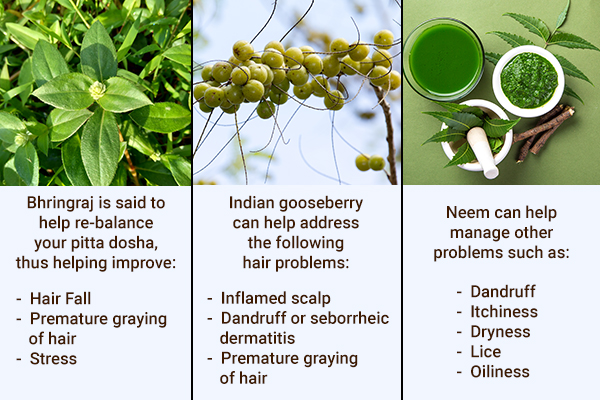
1. Bhringraj
Known as the king of herbs, bhringraj can be obtained in both powder and oil forms. The use of bhringraj is said to help rebalance the pitta dosha, thus helping improve:
- Hair fall
- Premature graying of hair
- Stress
2. Indian gooseberry
Indian gooseberry, commonly known as amla, is a popular and highly efficacious Ayurvedic ingredient used in the treatment of a wide range of health problems. (9)
Amla is generally available in powder form, which is rich in antioxidants such as polyphenols, ellagic acid, and vitamin C, which help lower oxidative stress. You can use amla extracts to regulate your scalp pH.
Indian gooseberry can help address the following hair problems:
- Inflamed scalp
- Dandruff or seborrheic dermatitis
- Premature graying of hair (9)
3. Neem
Neem leaves possess antimicrobial properties that prevent microbial overgrowth in the scalp. This herb also boosts blood circulation to the scalp, soothes inflammation, and helps manage other problems such as:
- Dandruff
- Itchiness
- Dryness
- Lice
- Oiliness
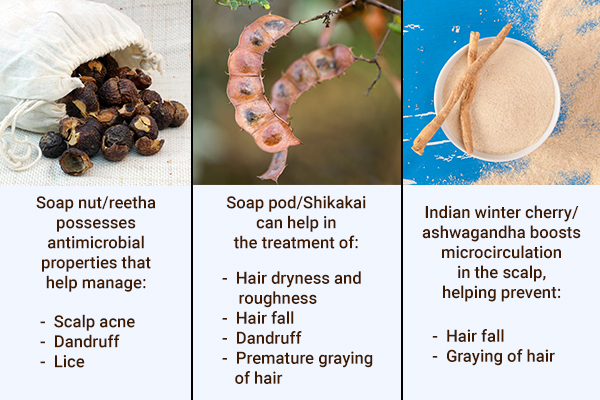
4. Soap nut
Soap nut, or reetha, is commonly used as a hair rinse to help promote healthy hair growth for a denser and more voluminous look. It also possesses antimicrobial properties that help manage:
- Scalp acne
- Dandruff
- Lice
5. Soap pod
Soap pod, or shikakai, is a popular hair cleanser generally used as a hair rinse. It has high amounts of antioxidants that help manage scalp inflammation.
Soap pod can help in the treatment of:
- Hair dryness and roughness
- Hair fall
- Dandruff
- Premature graying of hair
6. Indian winter cherry
The use of Indian winter cherry, commonly known as ashwagandha, is popular for boosting hair growth. (10) It helps lower cortisol levels in the blood, hence reducing stress and the associated hair fall.
Moreover, ashwagandha boosts microcirculation in the scalp. This prevents:
- Hair fall
- Graying of hair
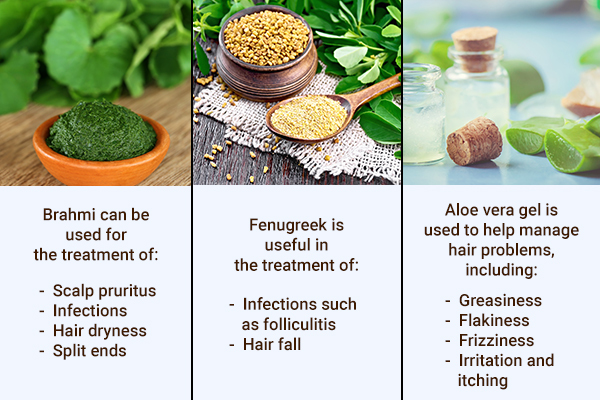
7. Brahmi
Brahmi is a commonly used Ayurvedic herb that improves hair health, making the hair strong, shiny, and thick.
It can also be used for the treatment of:
- Scalp pruritus
- Infections
- Hair dryness
- Split ends
8. Fenugreek
Fenugreek, commonly known as methi, promotes scalp health, improves blood cholesterol levels, and inhibits dihydrotestosterone activity, which causes alopecia. Therefore, fenugreek may be useful in the treatment of:
- Infections such as folliculitis
- Hair fall
9. Aloe vera gel
Aloe vera gel is used to manage a wide range of hair problems, (11) including:
- Greasiness
- Flakiness
- Frizziness
- Irritation and itching
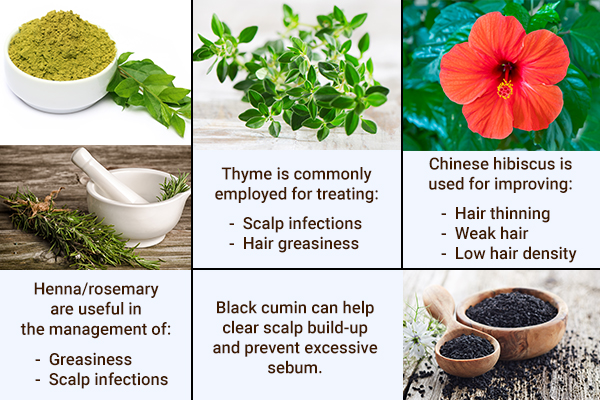
10. Henna/rosemary
Henna, which is also used as a hair dye, is primarily an efficient hair conditioner. Moreover, it helps control sebum production, which is useful in the management of:
- Greasiness
- Scalp infections
11. Thyme
Thyme is a potent antifungal, (12) anti-inflammatory, and antibacterial agent. It is commonly employed to treat:
- Scalp infections
- Hair greasiness
12. Chinese hibiscus
Chinese hibiscus, or japa, is a popular Ayurvedic plant. (13) Its extracts may increase hair follicle size, thus leading to the growth of thick hair.
Chinese hibiscus is commonly used to improve:
- Hair thinning
- Weak hair
- Low hair density
13. Black cumin
Black cumin, also known as kalonji, is a common Ayurvedic herb used for the treatment of different conditions. It can help clear scalp buildup and prevent excessive sebum production.
14. Other herbs
Several other herbs are a part of Ayurvedic hair treatment and care. These include, but are not limited to, ginseng, holy basil, cuscuta, night-flowering jasmine, and tridax.
Ayurvedic Oils for Hair
Apart from herbs, Ayurvedic treatments also use oils to improve hair health. These oils include:
- Bhringraj oil
- Castor oil
- Sesame seed oil
- Jatamansi essential oil
- Arnica oil
- Almond oil
- Coconut oil
- Yashtimadhu oil
- Olive oil
- Gunja oil
- Neem essential oil
- Lavender essential oil
- Rosemary essential oil
- Peppermint essential oil (14)
How to Use Ayurvedic Herbs and Oils for Hair Care
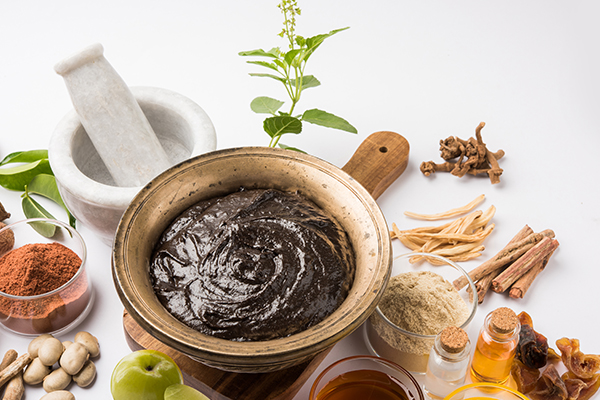
In Ayurvedic treatments, herbs are employed to improve hair health. Most of these herbs, commonly available as powders, are used to make hair masks in the following manner:
- Mix the powders with water to form a paste.
- Apply the paste to your scalp and hair roots.
- Leave it in for 15–20 minutes.
- Rinse using normal water.
- Shampoo only if there is a lingering smell; otherwise, condition as usual.
You can also make a combination of a few powders when making the mask. Some common examples include amla and ashwagandha, and shikakai and Indian gooseberry (for dying your hair).
Additionally, you can mix in honey, lemon juice, or yogurt to the mask for an added benefit of management of scalp infections, and buttermilk to help manage hair greasiness.
Moreover, you can make hair rinses of different Ayurvedic plants:
- Use the fresh juice of Indian gooseberry and mix it with water.
- Blend aloe vera gel with water to make aloe vera juice.
- Boil thyme, neem, or brahmi leaves in water, cool, and strain.
- Soak soap nuts in water overnight.
Use these rinses to wash your hair, followed by the application of a conditioner.
Ayurvedic oils, on the other hand, are used for scalp massage:
- Slightly warm the oil and apply it to the scalp. Always dilute essential oils with a carrier oil before use.
- Massage your roots and scalp with the oil for about 10–15 minutes.
- Leave it on for 20 minutes or overnight before washing your hair.
Alternatively, you can mix the oil in your shampoos or hair masks for use.
You can also try combining the oils for added benefits. Some common oil blends are:
- Neem essential oil with sesame seed oil or olive oil
- Bhringraj oil and jatamansi essential oil
- Bhringraj oil with peppermint or lavender essential oil
Ayurvedic Hair Care Measures: Dos and Don’ts

It is essential to take proper care of your hair to maintain a balance between your doshas, thus maintaining your prakriti and improving your hair health. Here are some self-care measures that are recommended by Ayurvedic science.
What to do:
- Wash your hair and scalp two to three times a week to maintain cleanliness.
- Massage your scalp to help improve circulation, thus improving hair strength and elasticity. (15)
- Detangle your hair using a soft-bristled, wide-toothed comb. Combing also helps distribute the natural scalp oils evenly through the hair.
- Trim your hair to get rid of split ends.
- Wear a hat or a scarf to prevent exposing your hair to pollutants. (16)
- Select hair products that contain Ayurvedic ingredients, such as ginseng, licorice, (17) and oils, that are most suitable to your prakriti. (18)
What to avoid:
- Refrain from using heat styling tools such as blow-dryers, straighteners, and curling irons as they cause dryness and damage. These tools also increase vata dosha.
- Avoid washing your hair with water with high mineral ion content.
- Do not use chemical treatments such as dyes, bleaches, and keratin. Instead, use natural dyes such as henna or vegetable hair dyes.
- Do not use hot water to wash your hair.
- Quit smoking as it is a common cause of premature graying of hair. (19)
ALSO READ: Ayurvedic Hair Care: Tips, Therapies and Diet for Healthy Hair
Final Word
Ayurveda is a popular alternative medicinal system based on the concept of three treatment principles, namely, nidana (diagnosis), chikitsa (self-care), and ahar (diet).
Ayurvedic treatments often use different herbs and oils, whose efficacies have been demonstrated in different scientific studies. Multiple Ayurvedic treatments are available for the management of hair problems such as premature graying, hair fall, and dandruff. You can try Ayurvedic medicine to improve your hair health in general.
- Was this article helpful?
- YES, THANKS!NOT REALLY


